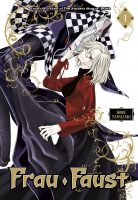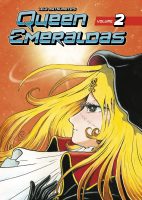My News and Reviews
Last week at Experiments in Manga I posted the Bookshelf Overload for September which includes lists of some of the manga and other books that I picked up last month (along with some brief commentary). Looking forward to future manga releases, Vertical Comics recently announced two new titles: Pop Team Epic by Bkub Okawa and The Delinquent Housewife! by Yoko Nemu. Seven Seas also had an interesting announcement to make. In addition to two licenses–Yuuna and the Haunted Hot Springs by Tadahiro Miura and World’s End Harem by Link and Kotaro Shono–Seven Seas is launching Ghost Ship, a new imprint for the publishers’ more mature titles.
Quick Takes
 Captain Harlock: Dimensional Voyage, Volume 1 written by Leiji Matsumoto, illustrated by Kouiti Shimaboshi. Although I immediately recognize the name of Captain Harlock, Dimensional Voyage is actually the first incarnation of his story that I’ve read or watched except for the short crossover manga included in Kodansha Comics’ recent release of Queen Emeraldas. (Emeraldas actually makes a brief appearance in the first volume of Dimensional Voyage, too.) My understanding is that Dimensional Voyage is either a reboot or retelling of Matsumoto’s original Captain Harlock manga, written by Matsumoto himself but illustrated by a different artist. The series is completely accessible to readers who are unfamiliar with Harlock though I suspect that established fans will find the manga to be appealing as well. Shimaboshi’s designs are obviously based on Matsumoto’s though many of the main characters are much more conventionally attractive in this version. Both the dialogue and the artwork of Dimensional Voyage tends to be very dramatic and at times even melodramatic, but I don’t at all consider that to be a bad thing. As for the story itself, the manga is just getting started. The first volume establishes the basic setting and premise, but much of it is spent introducing the legends surrounding Harlock, the series’ titular space pirate.
Captain Harlock: Dimensional Voyage, Volume 1 written by Leiji Matsumoto, illustrated by Kouiti Shimaboshi. Although I immediately recognize the name of Captain Harlock, Dimensional Voyage is actually the first incarnation of his story that I’ve read or watched except for the short crossover manga included in Kodansha Comics’ recent release of Queen Emeraldas. (Emeraldas actually makes a brief appearance in the first volume of Dimensional Voyage, too.) My understanding is that Dimensional Voyage is either a reboot or retelling of Matsumoto’s original Captain Harlock manga, written by Matsumoto himself but illustrated by a different artist. The series is completely accessible to readers who are unfamiliar with Harlock though I suspect that established fans will find the manga to be appealing as well. Shimaboshi’s designs are obviously based on Matsumoto’s though many of the main characters are much more conventionally attractive in this version. Both the dialogue and the artwork of Dimensional Voyage tends to be very dramatic and at times even melodramatic, but I don’t at all consider that to be a bad thing. As for the story itself, the manga is just getting started. The first volume establishes the basic setting and premise, but much of it is spent introducing the legends surrounding Harlock, the series’ titular space pirate.
 Jackass! by Scarlet Beriko. I forget exactly how Beriko’s work as a whole was first brought to my attention, but my curiosity was immediately piqued by Jackass! when SuBLime announced that it would be publishing the manga. It’s not a terribly uncommon trope in boys’ love for two friends to ultimately fall deeply in love with each other, so Jackass! isn’t particularly surprising in that way. However, it is the first manga that I’ve read in the genre in which women’s stockings provide the initial impetus for a relationship to take that particular turn. Keisuke’s best friend Masayuki has a leg fetish. In a rather awkward turn of events, and much to Keisuke’s embarrassment, Masayuki catches a glimpse of him wearing his sister’s pantyhose. Masayuki is instantly smitten with Keisuke’s perfect legs, which understandably complicates their relationship somewhat. At times Jackass! can be unexpectedly sweet and even touches on more sobering subject matter like homophobia, but for the most part it reads as a comedy not to be taken too seriously. Jackass! includes a strong supporting cast, including Keisuke’s older sister and his confidently gay cousin, which add a great deal to the manga; the entertaining and occasionally ridiculous character interactions are the highlight of the story. I enjoyed Jackass! and would certainly be interested in reading more of Beriko’s work.
Jackass! by Scarlet Beriko. I forget exactly how Beriko’s work as a whole was first brought to my attention, but my curiosity was immediately piqued by Jackass! when SuBLime announced that it would be publishing the manga. It’s not a terribly uncommon trope in boys’ love for two friends to ultimately fall deeply in love with each other, so Jackass! isn’t particularly surprising in that way. However, it is the first manga that I’ve read in the genre in which women’s stockings provide the initial impetus for a relationship to take that particular turn. Keisuke’s best friend Masayuki has a leg fetish. In a rather awkward turn of events, and much to Keisuke’s embarrassment, Masayuki catches a glimpse of him wearing his sister’s pantyhose. Masayuki is instantly smitten with Keisuke’s perfect legs, which understandably complicates their relationship somewhat. At times Jackass! can be unexpectedly sweet and even touches on more sobering subject matter like homophobia, but for the most part it reads as a comedy not to be taken too seriously. Jackass! includes a strong supporting cast, including Keisuke’s older sister and his confidently gay cousin, which add a great deal to the manga; the entertaining and occasionally ridiculous character interactions are the highlight of the story. I enjoyed Jackass! and would certainly be interested in reading more of Beriko’s work.
 Kiss Me at the Stroke of Midnight, Volume 1 by Rin Mikimoto. Hinana is known for her seriousness so most of her friends and classmates are unaware that she’s also a romantic hoping to find a fairy tale-like love. Kaede is a celebrity and rising star, admired for both his talent and incredibly good looks. The two of them meet, somewhat by chance, when Kaede is shooting on location at Hinana’s high school for an upcoming film and they end up hitting it off. Mikimoto’s artwork in Kiss Me at the Stroke of Midnight comes across as attractive but a little generic overall except for the hilariously exaggerated reaction shots drawn for comedic effect. And there is plenty of humor in the series. Kaede, idolized by his fans, does not at all have the personality that they would expect. He can be kind but, despite how he generally presents himself professionally, Kaede’s not exactly a refined gentleman. He’s also really into butts, and isn’t ashamed of that fact. Most people would probably be slightly taken aback by this, but Hinana finds his candidness refreshing. (I appreciated that aspect of his personality as well.) I was a little surprised by how much I enjoyed the first volume of Kiss Me at the Stroke of Midnight. I’m not overly interested in manga about celebrities, but Kaede is such a weirdo and Hinana is likeable, so I’m curious to see what turns their relationship might take from here.
Kiss Me at the Stroke of Midnight, Volume 1 by Rin Mikimoto. Hinana is known for her seriousness so most of her friends and classmates are unaware that she’s also a romantic hoping to find a fairy tale-like love. Kaede is a celebrity and rising star, admired for both his talent and incredibly good looks. The two of them meet, somewhat by chance, when Kaede is shooting on location at Hinana’s high school for an upcoming film and they end up hitting it off. Mikimoto’s artwork in Kiss Me at the Stroke of Midnight comes across as attractive but a little generic overall except for the hilariously exaggerated reaction shots drawn for comedic effect. And there is plenty of humor in the series. Kaede, idolized by his fans, does not at all have the personality that they would expect. He can be kind but, despite how he generally presents himself professionally, Kaede’s not exactly a refined gentleman. He’s also really into butts, and isn’t ashamed of that fact. Most people would probably be slightly taken aback by this, but Hinana finds his candidness refreshing. (I appreciated that aspect of his personality as well.) I was a little surprised by how much I enjoyed the first volume of Kiss Me at the Stroke of Midnight. I’m not overly interested in manga about celebrities, but Kaede is such a weirdo and Hinana is likeable, so I’m curious to see what turns their relationship might take from here.








